Abstract
This study assessed the effects of tetracycline (TC) on growth of Lemna aoukikusa and Spirodela polyrhiza under batch conditions. The duckweeds were exposed to a range of 0.0–5.0 mg L−1 of TC for 7 days in a medium containing 10 mg L−1 total nitrogen (TN) and 1 mg L−1 total phosphorus (TP). The relative growth rate (RGR) of each species was determined from the frond area measurement using image analysis. The EC50 values as the TC concentrations causing a 50% reduction in RGR, were 4.4 mg L−1 for L. aoukikusa and 0.65 mg L−1 for S. polyrhiza. At 5.0 mg L−1 TC, TP removal decreased to 60% in the L. aoukikusa culture and 77% in the S. polyrhiza culture, compared to 85–91% and 96%, respectively, under lower TC exposure. Nevertheless, TN and TP removals were not significantly impaired at TC concentrations found in swine wastewater. The TC removals were 76–94% for the L. aoukikusa culture and 68–91% for the S. polyrhiza culture, which were attributed to adsorption and plant uptake. These findings highlight the feasibility of duckweed-based stabilization ponds for simultaneous antibiotic attenuation and nutrient removal.
1. Introduction
Antibiotics have emerged as environmental pollutants due to their widespread use by humans, livestock, and aquaculture. For example, tetracycline (TC) is the most frequently detected antibiotic in swine wastewater, with concentrations up to 0.685 mg L−1 [1]. It binds reversibly to the 30S ribosomal subunit, blocking the attachment of aminoacyl-tRNA to the mRNA–ribosome complex, thereby inhibiting protein synthesis and cell growth in susceptible prokaryotes [2]. As it is not easily biodegraded [3], its concentrations in aquatic environments typically range from 0.1 to 1.0 mg L−1 and reach up to 5.0 mg L−1 [4].
Duckweeds, including members of the genera Lemna and Spirodela, are free-floating aquatic plants distributed in tropical and subtropical regions. They exhibit rapid growth through efficient nutrient uptake and play a pivotal role in preventing water pollution. In aquatic environments, interactions between plants and chemicals play a central role in the natural attenuation of contaminants. Duckweed systems act as small-scale treatment units, where plants directly absorb nutrients, while their root-associated microbial communities transform or degrade various organic pollutants. Several studies of duckweed-based stabilization ponds have been conducted to treat swine wastewater in the US [5,6], China [7], Brazil [8], Republic of Korea [9], and Vietnam [10]. Although the capacity of duckweed to remove nitrogen and phosphorus from wastewater is well established, the mechanisms by which antibiotics affect their growth, physiology, and nutrient removal efficiency remain largely unclear [11]. Duckweed, particularly Lemina species, has also been widely employed as a model organism for evaluating the toxicological effects of chemicals [12]. In this context, our research group developed a non-destructive image analysis method for quantifying the fronds of Lemna aoukikusa and Spirodela polyrhiza [13], which offers a robust tool for conducting bioassays of chemical toxicity.
Research on the effects of TC on plants, photosynthetic eukaryotes, remains limited. At low concentrations (0.01–1.0 mg L−1), it can slightly promote germination and shoot and root elongation in species such as lettuce, carrot, cucumber, and tomato, whereas at higher concentrations, it can inhibit these processes by 10–20% or more [14]. Reportedly, effective concentrations of TC inhibiting growth by 50% (EC50) of duckweed Lemna gibba was 1.1 mg L−1 [15]. Similarly, the EC50 values for growth and yield of Lemna minor L. were 1.96 mg L−1 and 1.62 mg L−1, respectively [16]. In contrast, much higher EC50 values for the frond area and dry mass of L. minor have been reported, at 770 mg L−1 and 1700 mg L−1, respectively [17]. Nutrient removal by Lemna aequinoctialis decreased when concentrations of oxytetracycline (OTC), a widely used tetracycline antibiotic, reached 1.0 mg L−1 [18]. Although it has negative effects on the nutrient production in L. aequinoctialis, 0.05 and 0.25 mg L−1 OTC promoted the synthesis of starches and flavonoids [19].
The aim of this study was to evaluate the nutrient and TC removal capacities of L. aoukikusa and S. polyrhiza, under batch conditions with high TC concentrations (1.0–5.0 mg L−1). The EC50 values of TC for the relative growth rate (RGR) of the duckweed species were evaluated based on frond area measured by image analysis.
2. Materials and Methods
2.1. Duckweed Species and Medium
Non-axenic L. aoukikusa and S. polyrhiza [13] were used in this study. L. aoukikusa has 1 to 4 leaves and 1 root. S. polyrhiza has 2 to 5 leaves and 5 to 11 roots. A modified Hoagland medium comprised NH4NO3 28.6 mg L−1, Na2SO4 239 mg L−1, NaH2PO4 3.87 mg L−1, MgSO4·7H2O 103 mg L−1, CaCl2·H2O 167 mg L−1, FeSO4 3.33 mg L−1, H3BO3 0.95 mg L−1, MnCl2·4H2O 0.39 mg L−1, CuSO4·5H2O 0.03 mg L−1, ZnSO4·7H2O 0.08 mg L−1, and Na2MoO4·4H2O 0.262 mg L−1 at pH 7. Initial total nitrogen (TN) and total phosphorus (TP) concentrations in the medium were 10 and 1 mg L−1, respectively. All chemicals were reagent-grade and purchased from Fujifilm Wako Pure Chemical Corporation, and used as received.
2.2. Batch Cultivation Conditions
Each duckweed sample was inoculated to 300 mL of modified Hoagland medium containing Tetracycline hydrochloride (Fujifilm Wako Pure Chemical Corp., Osaka, Japan) in glass bottles (diameter, 6 cm; depth, 8 cm). As a control experiment, medium without duckweed was also prepared. The experiments were performed in triplicates. The bottles were placed under an LED light with a 12 h d−1 photoperiod at 150 μmol m2 s−1 of the photosynthetic photon flux density for 7 d in a chamber at 25 °C. To minimize water evaporation while maintaining air exchange, each glass bottle was loosely covered with a transparent plastic wrap. The bottles were shaken gently once daily.
Water samples (5 mL) were collected from each bottle at the beginning (day 0) and the end (day 7) of cultivation for the analysis of TC, TN, and TP concentrations. Samples were withdrawn carefully using a sterile pipette to avoid disturbing the plants. The observed water loss due to evaporation was less than 5% of the initial volume.
2.3. Analytical Procedures
The fronds of duckweed species were measured using a previously reported analytical technique [13]. Briefly, photographs of the duckweed species with a red plastic marker (1.0 cm × 1.0 cm) were taken at a height of 5 cm from water surface using a camera (WF—40 w; Ricoh Japan Corp., Tokyo, Japan) for frond area estimation using an image analysis software (Photoshop CC 2021, namely, Ver. 22; Adobe Inc., Tokyo, Japan). Frond area was calculated by counting the green pixels and red marker pixels in the photographs in full HD resolution (1920 × 1080 pixels). This method used the Magic Wand and Histogram functions to determine the color distributions of fronds in the photographs.
The RGR of the duckweed species was calculated by fitting the exponential growth model (1) to the change in frond area, as previously reported [13].
where A represents the frond area (cm2) measured using image analysis, t signifies time (days, d), μ stands for relative growth rate (RGR) (d−1). Subscript 0 denotes the initial condition. The RGR was estimated by fitting the equation to the experimental data. The EC50 value was calculated using the linear regression model of the RGR against the TC concentration.
A = A0 exp (μt)
Prior to TC, TN, and TP analysis, the water samples were centrifuged at 5000 rpm for 10 min to remove suspended solids, and the supernatant was filtered through a 0.45 µm pore-size syringe filter. The filtrates were stored in glass vials in dark at 4 °C and analyzed within 24 h. The TC concentration was analyzed by liquid chromatography–mass spectrometry (LC-MS 8030, Shimadzu, Kyoto, Japan) with an InertSustain C18 column (2.1 mm i.d. × 150 mm, 5 µm; GL Science, Tokyo, Japan) maintained at 25 °C. The mobile phase consisted of acetonitrile and 0.2% formic acid in water (80:20, v/v), delivered at a flow rate of 0.2 mL min−1. The injection volume was 10 µL. Detection was performed in multiple reaction monitoring (MRM) mode using electrospray ionization (ESI) in positive mode, with characteristic precursor and product ion transitions for TC at m/z 445.2 → 410.1 and 445.2 → 154.0. Quantification was based on external calibration using standard solutions of tetracycline hydrochloride. The TN and TP concentrations were determined according to Standard Methods, using methods 4500-N and 4500-P [20].
3. Results
3.1. Effects of TC on Growth and Nutrient Removal by L. aoukikusa
Figure 1 illustrates in detail the results of the 7-day batch cultivation experiment using L. aoukikusa under different concentrations of TC. Throughout the cultivation period, the frond area displayed a consistent and progressive increase, and at most TC concentrations it nearly doubled by the end of the 7-day period. The only notable exception was observed at the highest TC concentration of 5.0 mg L−1, where growth was clearly suppressed, indicating a threshold beyond which the inhibitory effect of TC became dominant. As further depicted in Figure 2, fronds in the control treatment without TC supplementation maintained a healthy green coloration and vigorous appearance for the entire experimental period. In contrast, fronds grown in TC-containing media exhibited visible yellowing of the frond tissue, providing a clear indication of a physiological stress response attributable to antibiotic exposure. Such discoloration is often associated with chlorophyll degradation and impaired photosynthetic capacity, suggesting that TC exerted a measurable effect on the photosynthetic apparatus of the duckweed.
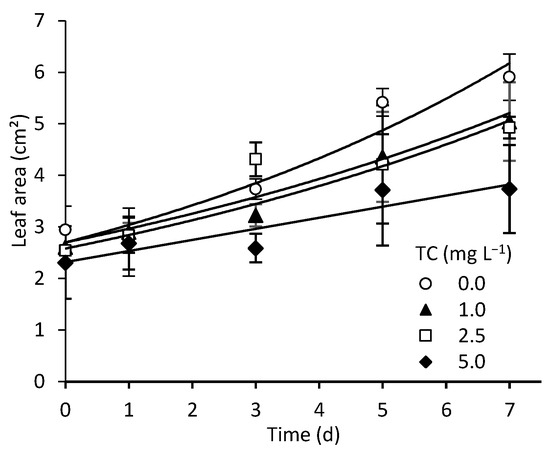
Figure 1.
Growth of L. aoukikusa in 7-day batch cultivation at various TC concentrations. Data represent avg ± std (n = 3). The RGR was calculated by fitting the exponential model to the measured data, 1.5 × 10−1, 9.9 × 10−2, 1.1 × 10−1, and 6.6 × 10−2 d−1 for the TC concentrations of 0.0, 1.0, 2.5, and 5.0 mg L−1, respectively.
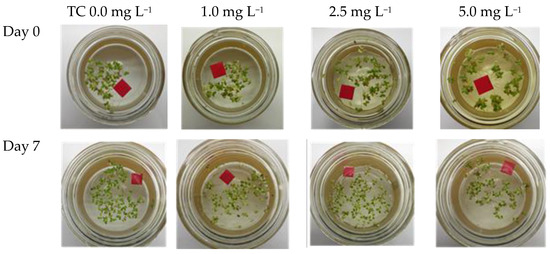
Figure 2.
Growth of L. aoukikusa in the 7-day batch cultivation at various TC concentrations. Red squares are 1.0 cm2 area markers.
The quantitative results for the RGR together with the 7-day removal efficiency of TC and nutrients are summarized in Figure 3. At the highest TC concentration of 5.0 mg L−1, the estimated RGR was markedly reduced, yielding 6.6 × 10−2 d−1, which was significantly lower than the value observed under control conditions without TC, 1.5 × 10−1 d−1 (p < 0.05). Based on the dose–response curve derived from these data, the EC50 for RGR was calculated to be 4.4 mg L−1 TC, providing a quantitative indicator of the degree of sensitivity of L. aoukikusa to antibiotic exposure. The comparison highlights that, while moderate concentrations of TC can be tolerated without drastic reductions in growth, exposure above a certain threshold leads to substantial physiological inhibition.
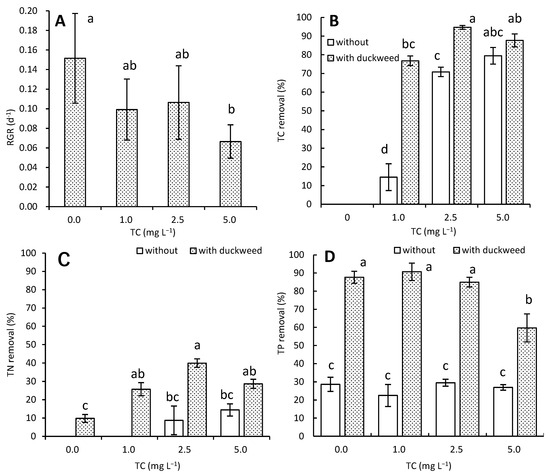
Figure 3.
Effects of the initial TC concentration on the growth of L. aoukikusa in 7-day batch cultivation. (A) RGR, (B) TC removal, (C) TN removal, and (D) TP removal. Data represent avg ± std (n = 3). Different letters indicate significant differences at p < 0.05 (Tukey’s HSD test).
A two-way ANOVA further revealed a statistically significant interaction between the initial TC concentration and the presence or absence of duckweed in terms of both TC and TN removal (p < 0.05). In the abiotic control without duckweed, TC removal ranged from 76% to 94%, which is consistent with earlier reports attributing such reductions primarily to passive adsorption of TC molecules onto the surface of the glass bottles [21]. However, in treatments containing duckweed, TC removal was further enhanced at 1.0 and 2.5 mg L−1, suggesting an additional biological contribution that may include uptake, transformation, or microbial degradation associated with the plant. For TN, no significant reduction was observed in the absence of duckweed, indicating that abiotic processes played a negligible role. In contrast, in the duckweed cultures, TN removal at TC concentrations of 1.0–5.0 mg L−1 ranged from 26% to 40%, which was substantially higher than the value of only 9.7% observed in TC-free conditions. These results suggest that L. aoukikusa was able to contribute actively to nitrogen uptake and assimilation even when subjected to antibiotic stress.
By contrast, no statistically significant interaction was detected for TP removal (p = 0.07). Nevertheless, the overall removal pattern demonstrated that TP elimination at 5.0 mg L−1 TC (60%) was clearly lower than that achieved at lower concentrations ranging from 0.0 to 2.5 mg L−1 TC, where the values reached 85–91%. In the absence of duckweed, TP removal remained limited to only 23–30%, which was attributed primarily to abiotic processes such as minor chemical precipitation rather than biological uptake. This difference underscores the critical role of duckweed in enhancing phosphorus removal efficiency under most conditions, while also revealing that high TC concentrations can partially impair this function.
3.2. Effects of TC on Growth and Nutrient Removal by S. polyrhiza
Figure 4 presents the results of the 7-day batch cultivation of S. polyrhiza under varying TC concentrations. In the control condition without TC, the frond area expanded steadily and continuously, with a particularly notable increase occurring between days three and seven, which is indicative of active vegetative growth during that phase. By contrast, at TC concentrations ranging from 1.0 to 5.0 mg L−1, the growth of S. polyrhiza was markedly suppressed, thereby demonstrating a clear dose-dependent inhibitory effect of TC on plant development. As illustrated in Figure 5, fronds exposed to TC-containing media exhibited visible yellowing of the surface tissue, a stress symptom commonly associated with reduced chlorophyll content and impaired photosynthetic function under chemical exposure.
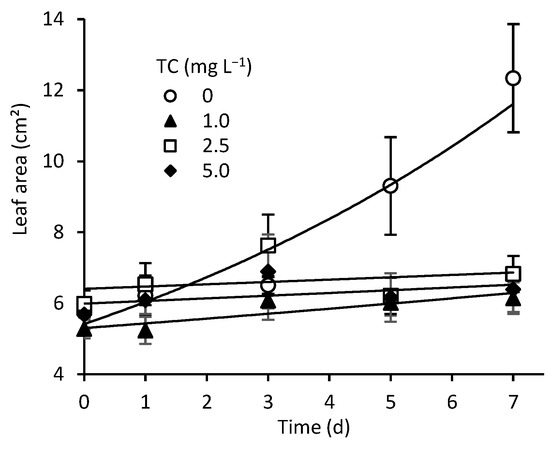
Figure 4.
Growth of S. polyrhiza in 7-day batch cultivation at various TC concentrations. Data represent avg ± std (n = 3). The RGR was calculated by fitting the exponential model to the measured data, 1.1 × 10−1, 2.4 × 10−2, 3.0 × 10−3, and 1.2 × 10−2 d−1 for the TC concentrations of 0.0, 1.0, 2.5, and 5.0 mg L−1, respectively.
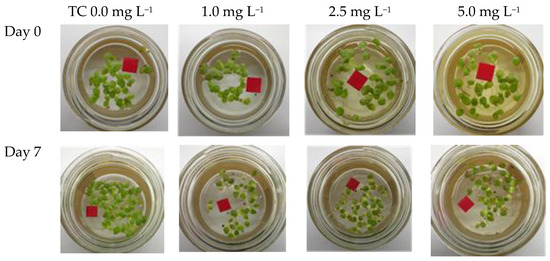
Figure 5.
Growth of S. polyrhiza in the 7-day batch cultivation at various TC concentrations. Red squares are 1.0 cm2 area markers.
The quantitative analysis of growth and nutrient removal performance is summarized in Figure 6. At TC concentrations of 1.0–5.0 mg L−1, the RGR remained extremely low, in the narrow range of 3.0 × 10−3–2.4 × 10−2 d−1, which was significantly lower than the RGR recorded in the control treatment (1.1 × 10−1 d−1) (p < 0.05). This pronounced decline in RGR highlights the strong inhibitory impact of TC even at relatively low concentrations. From these data, the EC50 value of RGR was calculated as 0.65 mg L−1 TC, indicating that S. polyrhiza is considerably more sensitive to TC than many other duckweed species reported in previous studies, and underscoring the variability in species-specific tolerance to antibiotics.
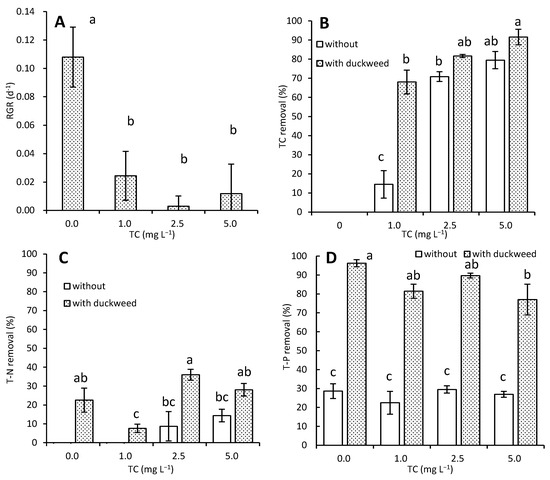
Figure 6.
Effects of the initial TC concentration on the growth of S. polyrhiza in 7-day batch cultivation. (A) RGR, (B) TC removal, (C) TN removal, and (D) TP removal. Data represent avg ± std (n = 3). Different letters indicate significant differences at p < 0.05 (Tukey’s HSD test).
Two-way ANOVA revealed a statistically significant interaction between the initial TC concentration and the presence of S. polyrhiza for both TC and TN removal (p < 0.05). In the presence of duckweed, TC removal was consistently higher, reaching values between 68% and 91%, which demonstrates that biological processes such as plant uptake or microbially mediated degradation contributed in addition to abiotic adsorption. TN removal also showed a variable response: in the absence of TC, removal was approximately 20%, whereas at 1.0 mg L−1 TC it declined to 7.6%. Interestingly, higher removal efficiencies were observed at 2.5 and 5.0 mg L−1 TC, where the values reached 36% and 28%, respectively. These findings suggest that S. polyrhiza and its associated microbiota possess some resilience to moderate antibiotic stress, allowing partial maintenance of nitrogen uptake and transformation pathways.
For TP, no significant interaction was observed (p = 0.07). Nevertheless, the presence of S. polyrhiza substantially improved TP removal compared with treatments lacking duckweed. However, at the highest TC concentration of 5.0 mg L−1, TP removal declined to 77%, which was significantly lower than the 96% removal achieved in the control condition without TC (p < 0.05). This outcome implies that elevated TC levels interfere with phosphorus assimilation, possibly through inhibition of plant metabolism or by reducing microbial activity in the duckweed rhizosphere, thereby limiting the overall phosphorus removal efficiency of the system.
4. Discussion
In this study, the RGR of duckweed species was quantified using an image analysis technique developed in a previous study [13] to evaluate antibiotic toxicity. The EC50 values of TC were 4.4 mg L−1 for L. aoukikusa and 0.65 mg L−1 for S. polyrhiza (Figure 3A and Figure 6A). These values are consistent with previously reported EC50 values, such as 1.1 mg L−1 for L. gibba [15] and 1.62–1.96 mg L−1 for L. minor [16], but substantially lower than 770 mg L−1 reported in another study for L. minor [17]. Notably, the EC50 value for S. polyrhiza was comparable to the high TC concentration (up to 0.685 mg L−1) in swine wastewater [1].
At 5.0 mg L−1 TC, the TP removal decreased to 60% in the L. aoukikusa culture and 77% in the S. polyrhiza culture, compared to 85–91% and 96%, respectively, under lower TC concentrations (Figure 3D and Figure 6D). Although nutrient removal in the duckweed cultures was not immediately inhibited within the TC concentrations typically found in swine wastewater, it is necessary to conduct long-term risk assessments under reduced RGR conditions, particularly for S. polyrhiza.
It was also demonstrated that duckweed culture achieved the TC removal of 76–94% in the L. aoukikusa culture (Figure 3B) and 68–91% in the S. polyrhiza culture (Figure 6B), which is considered to be primarily attributable to adsorption onto the glass bottle [21] and the biomass, and plant uptake [2,12], rather than undergoing significant biodegradation. In this study, adsorption onto glass surfaces was considered as one of the removal pathways of TC. However, we acknowledge that photolysis of TC under light exposure may contribute to its degradation. Because the experiments were conducted under visible light in the laboratory, where UV radiation was negligible, the photolytic contribution is expected to be limited. In our previous investigation [22], the variation in OTC concentration was examined under dark and fluorescent-light conditions comparable to those in the present study. In both conditions, the OTC concentration decreased by approximately 30% after one week, indicating that the apparent loss was primarily due to adsorption onto the inner surface of the container [22]. Nevertheless, future studies should include a dark control to quantitatively evaluate this effect.
Biological uptake by aquatic plants has also been documented in several studies. Although TC concentrations in duckweed biomass were not measured in this study, it has been reported that L. gibba exposed to wastewater containing approximately 10 µg L−1 TC accumulated it in the biomass at 99–123 µg g−1-dry [2]. Recent studies have confirmed similar uptake patterns in L. minor and S. polyrhiza under comparable conditions [17,19], suggesting that antibiotic accumulation is a consistent phenomenon across duckweed species. Future studies should include direct quantification of TC in plant tissues to better understand the fate of antibiotics in duckweed-based systems and to assess potential risks associated with biomass reuse.
The duckweed species used in this study were non-axenic. The duckweed rhizosphere harbors bacteria capable of degrading recalcitrant organic matter [23] and promoting plant growth [24]. However, exposure to TC may disrupt bacterial communities in the duckweed species. A previous study has reported that the metabolic activity of bacteria associated with duckweed was enhanced by 0.05 mg L−1 OTC [19]. The contribution of bacterial assimilation to TN and TP removal is probably minor compared with plant uptake; however, nitrifying bacteria are known to be sensitive to TC [25]. Several bacterial strains capable of degrading TC have been characterized [26,27]; for example, Klebsiella sp. SQY5 was shown to degrade TC while performing denitrification at 61 mg L−1 TC [26]. Similarly, Providencia stuartii TX2 removed about 72% of 400 mg L−1 TC in 48 h and pathways involving oxidation, hydroxylation, ring-opening, and de-grouping were proposed [27]. Such activity is unlikely to be significant in the present duckweed cultures because the rhizosphere microorganisms were not acclimated to TC and the experimental duration was relatively short. Understanding the effects of TC on these bacteria is a critical challenge.
5. Conclusions
This study demonstrated the potential of duckweed-based systems as effective treatment options for TC-containing swine wastewater. Duckweed cultures achieved the TC removals of 68–94% for its initial concentrations of 1.0–5.0 mg L−1, primarily through plant uptake and adsorption, while the nutrient removal was not adversely affected within the TC concentrations typically encountered in swine wastewater. However, elevated TC levels suppress the growth of duckweed species, particularly S. polyrhiza. These findings highlight the feasibility of duckweed-based stabilization ponds for simultaneous antibiotic attenuation and nutrient removal. Further investigation of antibiotic accumulation in biomass and the role of rhizosphere-associated bacteria will be critical to optimize treatment performance and ensure the safe reuse of harvested duckweed biomass.
Author Contributions
Conceptualization, U.T.T.D. and S.S.; methodology, U.T.T.D., T.S. and S.S.; software, U.T.T.D., S.N. and T.S.; validation, U.T.T.D. and S.N.; formal analysis, U.T.T.D., S.N. and T.S.; investigation, U.T.T.D. and S.N.; resources, S.S.; data curation, U.T.T.D. and T.S.; writing—original draft preparation, U.T.T.D. and S.N.; writing—review and editing, S.S.; visualization, U.T.T.D. and S.S.; supervision, S.S.; project administration, S.S. All authors have read and agreed to the published version of the manuscript.
Funding
This research received no external funding.
Institutional Review Board Statement
Not applicable.
Informed Consent Statement
Not applicable.
Data Availability Statement
The original contributions presented in the study are included in the article; further inquiries can be directed to the corresponding author.
Acknowledgments
The authors would like to express their sincere gratitude to Jun Nakajima, at Ritsumeikan University, for his valuable advice and guidance throughout this study.
Conflicts of Interest
The authors declare no conflicts of interest.
Abbreviations
| OTC | Oxytetracycline |
| RGR | Relative growth rate |
| TC | Tetracycline |
| TN | Total nitrogen |
| TP | Total phosphorus |
References
- Cheng, D.L.; Ngo, H.H.; Guo, W.S.; Chang, S.W.; Nguyen, D.D.; Liu, Y.W.; Wei, Q.; Wei, D. A critical review on antibiotics and hormones in swine wastewater: Water pollution problems and control approaches. J. Hazard. Mater. 2020, 387, 121682. [Google Scholar] [CrossRef] [PubMed]
- Topal, M.; Öbek, E.; Uslu Şenel, G.; Arslan Topal, E.I. Phytoremediation of tetracycline and degradation products from aqueous solutions. Pollution 2018, 4, 471–480. [Google Scholar] [CrossRef]
- Sánchez-Polo, M.; Velo-Gala, I.; López-Peñalver, J.J.; Rivera-Utrilla, J. Molecular imprinted polymer to remove tetracycline from aqueous solutions. Microporous Mesoporous Mater. 2015, 203, 32–40. [Google Scholar] [CrossRef]
- Campagnolo, E.R.; Johnson, K.R.; Karpati, A.; Rubin, C.S.; Kolpin, D.W.; Meyer, M.T.; Esteban, J.E.; Currier, R.W.; Smith, K.; Thu, K.M.; et al. Antimicrobial residues in animal waste and water resources proximal to large-scale swine and poultry feeding operations. Sci. Total Environ. 2002, 299, 89–95. [Google Scholar] [CrossRef]
- Bergmann, B.A.; Cheng, J.; Classen, J.; Stomp, A.M. Nutrient removal from swine lagoon effluent by duckweed. Trans. ASAE 2000, 43, 263–269. [Google Scholar] [CrossRef]
- Cheng, J.; Landesman, L.; Bergmann, B.A.; Classen, J.J.; Howard, J.W.; Yamamoto, Y. Nutrient removal from swine lagoon liquid by Lemna minor 8627. Trans. ASAE 2002, 45, 1003–1010. [Google Scholar] [CrossRef]
- Xu, J.; Shen, G. Effects of harvest regime and water depth on nutrient recovery from swine wastewater by growing Spirodela oligorrhiza. Water Environ. Res. 2011, 83, 2049–2056. [Google Scholar] [CrossRef]
- Mohedano, R.A.; Costa, H.R.; Tarares, A.; Filho, P.B. High nutrient removal rate from swine wastes and protein biomass production by full-scale duckweed ponds. Bioresour. Technol. 2012, 112, 98–104. [Google Scholar] [CrossRef]
- Sudiarto, S.I.A.; Renggaman, A.; Choi, H.L. Floating aquatic plants for total nitrogen and phosphorus removal from treated swine wastewater and their biomass characteristics. J. Environ. Manag. 2019, 231, 763–769. [Google Scholar] [CrossRef]
- Dinh, T.T.U.; Soda, S.; Nguyen, T.A.H.; Nakajima, J.; Cao, T.H. Nutrient removal by duckweed from anaerobically treated swine wastewater in lab-scale stabilization ponds in Vietnam. Sci. Total Environ. 2020, 772, 137854. [Google Scholar] [CrossRef] [PubMed]
- Nguyen, T.A.H.; Bui, T.H.; Nguyen, T.T.; Dan, A.; Soda, S. Constructed wetlands for sustainable bioremediation of antibiotics from wastewater: Potential and challenge. In Nature-Based Solutions for Urban Sustainability; Lens, P., Thanh, B.X., Eds.; IWA-publishing: London, UK, 2025; pp. 61–95. [Google Scholar] [CrossRef]
- Iatrou, E.A.; Gatidou, G.; Damalas, D.; Thomaidis, N.S.; Stasinakis, A.S. Fate of antimicrobials in duckweed Lemna minor wastewater treatment systems. J. Hazard. Mater. 2017, 330, 116–126. [Google Scholar] [CrossRef]
- Dinh, T.T.U.; Semba, S.; Nakajima, J.; Soda, S. Image analysis for estimation of biomass and nutrient removal of duckweed Lemna aoukikusa, Spirodela polyrhiza, and Wolffia globosa in lab-scale cultivation. Jpn. J. Water Treat. Biol. 2022, 58, 35–43. [Google Scholar] [CrossRef]
- Pan, M.; Chu, L.M. Phytotoxicity of veterinary antibiotics to seed germination and root elongation of crops. Ecotoxicol. Environ. Saf. 2016, 126, 228–237. [Google Scholar] [CrossRef] [PubMed]
- Brain, R.A.; Johnson, D.J.; Richards, S.M.; Sanderson, H.; Sibley, P.K.; Solomon, K.R. Effects of 25 pharmaceutical compounds to Lemna gibba using a seven-day static-renewal test. Environ. Toxicol. Chem. 2004, 23, 371–382. [Google Scholar] [CrossRef]
- Baciak, M.; Sikorski, L.; Piotrowicz-Cieslak, A.I.; Adomos, B. Content of biogenic amines in Lemna minor (common duckweed) growing in medium contaminated with tetracycline. Aquat. Toxicol. 2016, 180, 95–102. [Google Scholar] [CrossRef]
- Krupka, M.; Michalczyk, D.J.; Žaltauskaitė, J.; Sujetovienė, G.; Glowacka, K.; Grajek, H.; Wierzbicka, M.; Piotrowicz-Cieślak, A.I. Physiological and biochemical parameters of common duckweed Lemna minor after the exposure to tetracycline and the recovery from this stress. Molecules 2021, 26, 6765. [Google Scholar] [CrossRef] [PubMed]
- Hu, H.; Zhou, Q.; Li, X.; Lou, W.; Du, C.; Teng, Q.; Zhang, D.; Liu, H.; Zhong, Y.; Yang, C. Phytoremediation of anaerobically digested swine wastewater contaminated by oxytetracycline via Lemna aequinoctialis: Nutrient removal, growth characteristics and degradation pathways. Bioresour. Technol. 2019, 291, 121853. [Google Scholar] [CrossRef] [PubMed]
- Hu, H.; Li, X.; Wu, S.; Lou, W.; Yang, C. Effects of long-term exposure to oxytetracycline on phytoremediation of swine wastewater via duckweed systems. J. Hazard. Mater. 2021, 414, 125508. [Google Scholar] [CrossRef]
- APHA/AWWA/WEF. Standard methods for the examination of water and wastewater. In Standard Methods; APHA/AWWA/WEF: Washington, DC, USA, 2012; p. 541. [Google Scholar]
- Ciarlone, A.E.; Fry, B.W.; Ziemer, D.M. Some observations on the adsorption of tetracyclines to glass and plastic labware. Microchem. J. 1990, 42, 250–255. [Google Scholar] [CrossRef]
- Sawada, K.; Hojo, Y.; Shimizu, T.; Soda, S. Soil adsorption, photodegradation, and removal of antibiotics from water by duckweed: Case studies examining erythromycin, lincomycin, and others. J. Environ. Conserv. Eng. 2023, 52, 296–304. (In Japanese) [Google Scholar] [CrossRef]
- Yamaga, F.; Washio, K.; Morikawa, M. Sustainable biodegradation of phenol by Acinetobacter calcoaceticus P23 isolated from the rhizosphere of duckweed Lemna aoukikusa. Environ. Sci. Technol. 2010, 44, 6470–6474. [Google Scholar] [CrossRef]
- Ishizawa, H.; Kuroda, M.; Morikawa, M.; Ike, M. Evaluation of environmental bacterial communities as a factor affecting the growth of duckweed Lemna minor. Biotechnol. Biofuels 2017, 10, 62. [Google Scholar] [CrossRef]
- Langbehn, R.K.; Michels, C.; Soares, H.M. Tetracyclines lead to ammonium accumulation during nitrification process. J. Environ. Sci. Health A 2020, 55, 1021–1031. [Google Scholar] [CrossRef] [PubMed]
- Shao, S.; Hu, Y.; Cheng, C.; Cheng, J.; Chen, Y. Simultaneous degradation of tetracycline and denitrification by a novel bacterium, Klebsiella sp. SQY5. Chemosphere 2018, 209, 35–43. [Google Scholar] [CrossRef] [PubMed]
- Pei, Y.; Lei, A.; Yang, S.; Chen, H.; Liu, X.; Liu, L.; Kang, X. Biodegradation and bioaugmentation of tetracycline by Providencia stuartii TX2: Performance, degradation pathway, genetic background, key enzymes, and application risk assessment. J. Hazard. Mater. 2024, 477, 135231. [Google Scholar] [CrossRef] [PubMed]
Disclaimer/Publisher’s Note: The statements, opinions and data contained in all publications are solely those of the individual author(s) and contributor(s) and not of MDPI and/or the editor(s). MDPI and/or the editor(s) disclaim responsibility for any injury to people or property resulting from any ideas, methods, instructions or products referred to in the content. |
© 2025 by the authors. Licensee MDPI, Basel, Switzerland. This article is an open access article distributed under the terms and conditions of the Creative Commons Attribution (CC BY) license (https://creativecommons.org/licenses/by/4.0/).